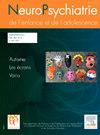通过早产儿诊所测试替代Psychomotricite Prematurite环境情感(GAPPEA)
Q4 Medicine
Neuropsychiatrie de l''Enfance et de l''Adolescence
Pub Date : 2025-09-01
DOI:10.1016/j.neurenf.2025.07.002
引用次数: 0
摘要
目的:本文根据CAMSP临床实践中早产儿及其家庭的需求,提出了GAPPEA网格(格栅替代性心理运动-环境-情感-环境-情感网格)的实施方法。研究人员对81名8个月大的婴儿(8个月大,真实或矫正,包括早产儿)进行了网格测试,并与数十名精神运动治疗师就网格的使用建立了联系。结果除了从参与研究的心理医生那里得到的反馈和他们强调的兴趣点之外,网格的使用使得可以明确早产儿心理运动发展的某些特殊性和弱点(感觉烦躁、过度伸展模式的流行、坐着的不良影响等)以及它们对早产儿心理运动发展的影响。它还定义了它们对与父母互动的影响(这里通过它们对携带、喂养、玩耍和交流的影响来衡量)。根据本实验,网格的使用可以对相关婴儿的潜力和困难进行深入的临床阅读,有助于更好地识别某些临床症状及其问题。它还定义了考虑照顾孩子的精确指示,并在非常具体的方面指导父母。在这种情况下,网格的使用强调了其处理的相关性,从而打开了多样化使用的可能性,并在未来通过其他研究将其作为一种支持来改进它。它为心理医生在对婴儿及其父母的治疗支持领域的评估和护理活动提供了一个实用和有用的工具。本文章由计算机程序翻译,如有差异,请以英文原文为准。
Mise à l’épreuve de la Grille Alternative Psychomotricité Prématurité Environnement Affectivité (GAPPEA) via la clinique de la prématurité
Objectives
This article presents an implementation of the GAPPEA grid (Grille Alternative Psychomotricité Environnement Affectivité–Alternative Psychomotor Environment Affectivity Grid), based on the needs encountered in clinical practice in CAMSP with regards to babies born prematurely and their families.
Patients and method
The grid was tested on a cohort of 81 8-month-old babies (8 months of age, real or corrected, including premature babies) involving the networking of several dozen psychomotor therapists around its use.
Results
In addition to the feedback received from the psychomotricians who took part in the study and who emphasised the points of interest, the use of the grid made it possible to specify certain particularities and weaknesses in the psychomotor development of premature babies (sensory irritability, prevalence of hyper-extension patterns, undesirable effects of sitting, etc.) as well as their impact on the psychomotor development of premature babies. It also defined their impact on interactions with parents (which were measured here via their effects on carrying, feeding, play and communication).
Discussion
In light of this experiment, the use of the grid enabled an in-depth clinical reading of the potential and difficulties of the babies concerned, facilitating better identification of certain clinical signs and their issues. It also defined precise indications for thinking about their care and guiding parents on very concrete aspects.
Conclusions
The use of the grid in this context underlines the relevance of its handling, thus opens the possibility of diversifying its use and improving it in the future through other research by using it as a support. It offers a practical and useful tool for psychomotricians in their assessment and care activities in the field of therapeutic support for babies and their parents.
求助全文
通过发布文献求助,成功后即可免费获取论文全文。
去求助
来源期刊

Neuropsychiatrie de l''Enfance et de l''Adolescence
Medicine-Pediatrics, Perinatology and Child Health
CiteScore
0.60
自引率
0.00%
发文量
61
期刊介绍:
Organ of the Société française de psychiatrie de enfant et de adolescent, Neuropsychiatrie de enfance et de adolescence tackles all fields of child-adolescent psychiatry and offers a link between field and clinical work. As a reference and training tool for students and practitioners, the journal publishes original papers in child psychiatry as well as book reviews and conference reports. Each issue also offers a calendar of the main events dealing with the speciality.
 求助内容:
求助内容: 应助结果提醒方式:
应助结果提醒方式:


